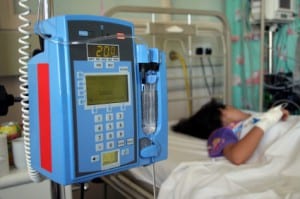Underreported needlestick injuries among healthcare workers

Needlestick injuries (NSIs) among healthcare workers (HCWs) pose an important health challenge and several pieces of evidence show that in many cases HCWs do not report the injury” Joukar et al (2018). Abstract: BACKGROUND: Needlestick injuries (NSIs) among healthcare workers (HCWs) pose an important health challenge and several pieces of evidence show that in many […]
Propofol infusion syndrome is prevented with a prospective screening protocol

Propofol infusion syndrome (PIS) is a potentially lethal complication of propofol marked by rhabdomyolysis, metabolic acidosis, and cardiac arrhythmias or collapse. The objective of this study was to determine the effectiveness of a prospective screening protocol to prevent PIS” Schroeppel et al (2018). Abstract: Propofol infusion syndrome (PIS) is a potentially lethal complication of propofol […]
IV Furosemide administration options – continuous infusion versus intermittent boluses

The administration of loop diuretics in the management of acute decompensated heart failure (ADHF) whether IV boluses or continuous infusion is still controversial. We intended to evaluate differences between the two administration routes on the thoracic fluid content (TFC) and the renal functions” Ragab et al (2018). Abstract: INTRODUCTION: The administration of loop diuretics in […]
Thromboembolism prophylaxis in high-risk critically ill patients

This review discusses observational studies identifying patients at risk of thromboprophylaxis failure and critiques clinical studies evaluating novel thromboprophylaxis strategies in high-risk, critically ill patients with a focus on their limitations” Lewis et al (2018). Abstract: Venous thromboembolism (VTE) is a major health concern associated with significant morbidity and mortality. Critically ill patients are at […]
Vessel health and preservation framework evaluation

Vascular access is an important part of many patient care management plans, but has unwanted risks. A working group led by the Infection Prevention Society (IPS) produced a Vessel Health and Preservation (VHP) Framework” Burnett et al (2018). Abstract: BACKGROUND: Vascular access is an important part of many patient care management plans, but has unwanted […]
Extensive overview of central venous access device complications

Central venous catheterization is a skill frequently needed in the acute care setting. Patients who have multiple, noncompatible intravenous (IV) medications with limited peripheral access, or who are being given vasoactive or phlebosclerotic agents may not be suitably cared for with a peripheral IV alone” England and Bhimji (2018). Excerpt: Central venous catheterization is a […]
Pancreatitis treatment options explored in this publication

Acute triglyceride (TG) lowering therapy is crucial in the early treatment of hypertriglyceridemia (HTG)-induced pancreatitis. Data concerning continuous intravenous infusion of insulin and heparin therapy (IHT) as an equivalent option to plasma exchange (PE) in HTG-induced pancreatitis are limited” Jin et al (2018). Abstract: BACKGROUND: Acute triglyceride (TG) lowering therapy is crucial in the early […]
Recidivism in intravenous drug users with infective endocarditis

IVDU patients who underwent cardiac surgery for IE experienced higher risks of perioperative adverse events and inferior mid-term survival compared to non-IVDU, despite being younger and having less comorbidities” Tiako et al (2018). Abstract: BACKGROUND: The proportional incidence of intravenous drug use (IVDU) associated infective endocarditis cases requiring surgery has increased significantly, mirroring the national […]
Central venous pressure is a measure of pressure in the superior vena cava

Central venous pressure is a measure of pressure in the superior vena cava which can be used as an estimation of preload and right atrial pressure” Shah and Louis (2018). Excerpt: Central venous pressure is a measure of pressure in the superior vena cava which can be used as an estimation of preload and right […]
Peripheral parenteral nutrition osmolality algorithm

Osmotic stress is a physical risk factor for adverse events related to peripheral parenteral nutrition (PN) administration, such as infiltration. We sought to improve prediction of compounded PN osmolality utilizing basic nutrient solutions available to North American neonatal intensive care units” Borenstein et al (2018). Abstract: BACKGROUND: Osmotic stress is a physical risk factor for […]
Technique for removing a fibrin sheath from implantable port

We describe a novel technique for removing a fibrin sheath by exteriorizing the catheter through the neck entry site, stripping the fibrin sheath from the catheter manually under sterile conditions and replacing the catheter via a peel-away sheath introduced through the same skin incision as an alternative to complete port replacement or attempted catheter stripping” […]
Implantable port misplacement as a cause of catheter malfunction

However, port CVC misplacement may lead to catheter malfunction (such as partial or total catheter blockade), which might be complicated by thrombosis and catheter superinfections, and these in turn may lead to pulmonary embolism and bloodstream infections” Mauri et al (2018). Abstract: The use of port central venous catheters (CVCs) for chemotherapeutical use has seen […]
PICC placement in medical-surgical neonatal intensive care units

To compare outcomes of peripherally inserted central catheters (PICCs) placed in the upper extremity (UE) versus the lower extremity (LE) in a quaternary medical-surgical neonatal intensive care unit (NICU)” Elmekkawi et al (2018). Abstract: OBJECTIVE: To compare outcomes of peripherally inserted central catheters (PICCs) placed in the upper extremity (UE) versus the lower extremity (LE) […]
Air embolism following removal of central venous catheter

We report a case of cerebral air embolism with loss of consciousness after removal of CVC caused by pulmonary arteriovenous malformation (PAVM)” Kugiyama et al (2018). Abstract: Cerebral air embolism following central venous catheter (CVC) removal is extremely rare. We report a case of cerebral air embolism with loss of consciousness after removal of CVC […]
Sodium citrate versus heparin as IV locking solution for central venous catheters

Citrate 4% lock solution is equally effective as heparin in maintaining catheter patency in dialysis patients. It may have a favorable effect on prevention of catheter-related infection due to its additional antiseptic properties as compared to heparin” Abdel Azim et al (2018). Abstract: BACKGROUND: Limited reports are available on the role of 4% citrate as […]
Narrative review of long-term central venous access devices for the intensivist

Long-term central venous access devices are increasingly prevalent and consequently often encountered by intensivists” Moir and Bodenham (2018). Abstract: Long-term central venous access devices are increasingly prevalent and consequently often encountered by intensivists. This review introduces the different types of long-term central venous access devices, outlines their potential utility, examines potential complications associated with their […]
Vascular access thrombosis contributory factors in hemodialysis patients

The aim of this study was to assess von Willebrand factor (VWF), and a disintegrin and metalloproteinase with eight thrombospondin-type 1 motif (ADAMTS13) levels in HD patients and their association with vascular access thrombosis (VAT)” Elzorkany et al (2018). Abstract: Vascular access complications are major issues in hemodialysis (HD) patients, which increase their morbidity and […]
How to use adrenaline in the acute treatment of anaphylaxis

The immediate treatment of patients with anaphylaxis is held to be adequate, yet major deficiencies remain in their further diagnostic evaluation, in the prescribing of emergency medications, and in patient education” Ring et al (2018). Abstract; BACKGROUND: Anaphylaxis is the most serious manifestation of an immediate allergic reaction and the most common emergency event in […]
Technique for placement of tunneled cuffed central venous catheter

We retrospectively compared the Micropuncture kit with the standard 18-gauge Angiocath IV catheter for tunneled cuffed catheter insertion in the right jugular vein” Lee et al (2018). Abstract: Introduction: Tunneled cuffed catheters provide stable, instantaneous, long-term intravenous access for hemodialysis. Because catheterization is often performed in emergency situations, speed and accuracy are emphasized. Methods: We […]
IV lock solution for central venous catheter salvage

We report several cases of catheter salvage using antibiotic lock solution in staphylococcal bacteremia with the purpose of stimulating the interest in randomized clinical trials. Evaluating the risk and benefits of catheter salvage in this patient subset in light of optimized systemic antibiotic dosing, improved lock solution use, and multidisciplinary involvement, balanced with the critical […]
Predicting and preventing needlestick and sharp injuries

The aim of the present study was to use a systematic approach for predicting and reducing these injuries” Akbari et al (2018). Abstract: PURPOSE: Recent studies have shown that the rate of needlestick and sharp injuries (NSIs) are unacceptably high in Iranian hospitals. The aim of the present study was to use a systematic approach […]
HIV postexposure prophylaxis among professional health-care workers

Accidental transmission of HIV infection to HCWs during occupational exposure is a real threat today. The study aimed to assess the knowledge, attitude, and practice of postexposure prophylaxis (PEP) among HCWs in a tertiary health institution in Sokoto, Northwestern Nigeria” Oche et al (2018). Abstract: INTRODUCTION: The prevention of human immunodeficiency virus (HIV/AIDS) among health-care […]
What is the stability of intravenous vitamin C solutions

Our findings suggest that vitamin C solutions of 1.5 g per 50 mL of 0.9% saline and 2.5 g per 50 mL of D5W remain stable for up to 96 hours and do not need to be protected from light” Carr et al (2018). Abstract: BACKGROUND: There has recently been a surge of interest in […]
Difficult vascular access solution in a patient on chronic hemodialysis

atients with central venous catheters (CVCs) are prone for recurrent infections, vascular thrombosis, and vascular stenosis, which contribute to significant morbidity and mortality. We present a case of a 31-year-old male who had a transhepatic hemodialysis catheter lasting for 4.5 years” Kumar et al (2018). Extract: Long-term chronic hemodialysis in patients with end-stage renal failure […]
Non-antibiotic antimicrobial catheter lock solutions in patients on home parenteral nutrition

Recently, however, with the advent of non-antibiotic antimicrobial catheter lock solutions, this approach is gaining popularity as a promising method to decrease rates of CRBSI in HPN patients” Noelting et al (2018). Abstract: Patients on home parenteral nutrition (HPN) are dependent on central venous access for long-term sustenance, and catheter-related bloodstream infections (CRBSIs) are a […]
Frequency of surveillance for central-line-associated bloodstream infections

Sampling over 2 fixed days per week provides a valid alternative to daily collection of CLABSI denominator data” Kourkouni et al (2018). Abstract: BACKGROUND: Active daily surveillance of central-line days (CLDs) in the assessment of rates of central-line-associated bloodstream infections (CLABSIs) is time-consuming and burdensome for healthcare workers. Sampling of denominator data is a method […]
Repair of damaged central venous catheters is safe and doubles catheter survival

The aim of this study was to evaluate the effectiveness and safety of catheter repair in our cohort of intestinal failure patients” Wouters et al (2018). Abstract: BACKGROUND & AIMS: Repeated central venous catheter loss due to complications, including material breakage, compromises the options to obtain adequate vascular access in home parenteral nutrition (HPN) patients. […]
Patient self-management of PICC assisted with WeChat smartphone application

It appears that WeChat follow-up can help improve the incidence of complications, self-care ability, PICC maintenance dependence, and patient satisfaction. However, the WeChat application itself cannot improve patients’ self-management ability. Abstract: WeChat is a smartphone application that may help patients self-manage peripherally inserted central catheters (PICC), although additional data are needed regarding this topic. This […]
Needlestick injuries are the main cause of biological injuries to health care workers

Three hundred and thirty-five injuries were reported from 2010 to 2016, occurring mainly in the morning (54%) and frequently caused by needlestick (70%)” Cofini et al (2018). Abstract: BACKGROUND: Biological injuries are the most common and serious among health care workers. OBJECTIVES: This study aims to estimate the injuries’ incidence, job distribution and temporal trend […]
Preventing central venous catheter protein adsorption with water infused surface protection

We present further analysis of the previously proposed water infused surface protection (WISP) technology, an active method to reduce protein adsorption and effectively disrupt adsorbed protein sheaths on the inner surface of CVCs” Sutherland et al (2018). Abstract: Central venous catheters (CVCs) are implanted in the majority of dialysis patients despite increased patient risk due […]

